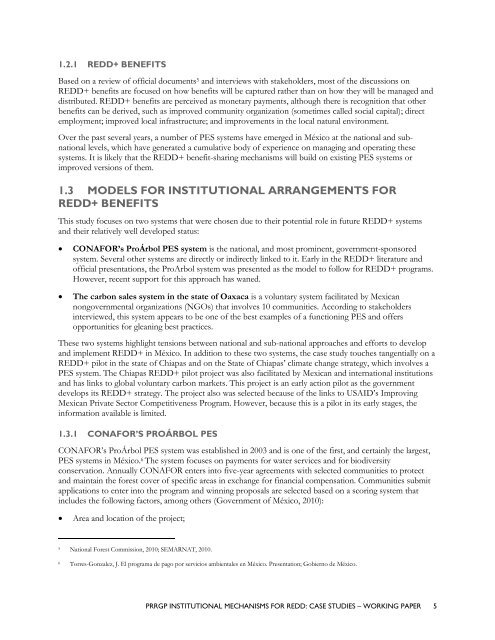Institutional Mechanisms for REDD+ - Case Studies Working Paper
Institutional Mechanisms for REDD+ - Case Studies Working Paper
Institutional Mechanisms for REDD+ - Case Studies Working Paper
Create successful ePaper yourself
Turn your PDF publications into a flip-book with our unique Google optimized e-Paper software.
1.2.1 <strong>REDD+</strong> BENEFITS<br />
Based on a review of official documents 5 and interviews with stakeholders, most of the discussions on<br />
<strong>REDD+</strong> benefits are focused on how benefits will be captured rather than on how they will be managed and<br />
distributed. <strong>REDD+</strong> benefits are perceived as monetary payments, although there is recognition that other<br />
benefits can be derived, such as improved community organization (sometimes called social capital); direct<br />
employment; improved local infrastructure; and improvements in the local natural environment.<br />
Over the past several years, a number of PES systems have emerged in México at the national and subnational<br />
levels, which have generated a cumulative body of experience on managing and operating these<br />
systems. It is likely that the <strong>REDD+</strong> benefit-sharing mechanisms will build on existing PES systems or<br />
improved versions of them.<br />
1.3 MODELS FOR INSTITUTIONAL ARRANGEMENTS FOR<br />
<strong>REDD+</strong> BENEFITS<br />
This study focuses on two systems that were chosen due to their potential role in future <strong>REDD+</strong> systems<br />
and their relatively well developed status:<br />
� CONAFOR’s ProÁrbol PES system is the national, and most prominent, government-sponsored<br />
system. Several other systems are directly or indirectly linked to it. Early in the <strong>REDD+</strong> literature and<br />
official presentations, the ProArbol system was presented as the model to follow <strong>for</strong> <strong>REDD+</strong> programs.<br />
However, recent support <strong>for</strong> this approach has waned.<br />
� The carbon sales system in the state of Oaxaca is a voluntary system facilitated by Mexican<br />
nongovernmental organizations (NGOs) that involves 10 communities. According to stakeholders<br />
interviewed, this system appears to be one of the best examples of a functioning PES and offers<br />
opportunities <strong>for</strong> gleaning best practices.<br />
These two systems highlight tensions between national and sub-national approaches and ef<strong>for</strong>ts to develop<br />
and implement <strong>REDD+</strong> in México. In addition to these two systems, the case study touches tangentially on a<br />
<strong>REDD+</strong> pilot in the state of Chiapas and on the State of Chiapas‘ climate change strategy, which involves a<br />
PES system. The Chiapas <strong>REDD+</strong> pilot project was also facilitated by Mexican and international institutions<br />
and has links to global voluntary carbon markets. This project is an early action pilot as the government<br />
develops its <strong>REDD+</strong> strategy. The project also was selected because of the links to USAID‘s Improving<br />
Mexican Private Sector Competitiveness Program. However, because this is a pilot in its early stages, the<br />
in<strong>for</strong>mation available is limited.<br />
1.3.1 CONAFOR’S PROÁRBOL PES<br />
CONAFOR‘s ProÁrbol PES system was established in 2003 and is one of the first, and certainly the largest,<br />
PES systems in México. 6 The system focuses on payments <strong>for</strong> water services and <strong>for</strong> biodiversity<br />
conservation. Annually CONAFOR enters into five-year agreements with selected communities to protect<br />
and maintain the <strong>for</strong>est cover of specific areas in exchange <strong>for</strong> financial compensation. Communities submit<br />
applications to enter into the program and winning proposals are selected based on a scoring system that<br />
includes the following factors, among others (Government of México, 2010):<br />
� Area and location of the project;<br />
5 National Forest Commission, 2010; SEMARNAT, 2010.<br />
6 Torres-Gonzalez, J. El programa de pago por servicios ambientales en México. Presentation; Gobierno de México.<br />
PRRGP INSTITUTIONAL MECHANISMS FOR REDD: CASE STUDIES – WORKING PAPER 5

















